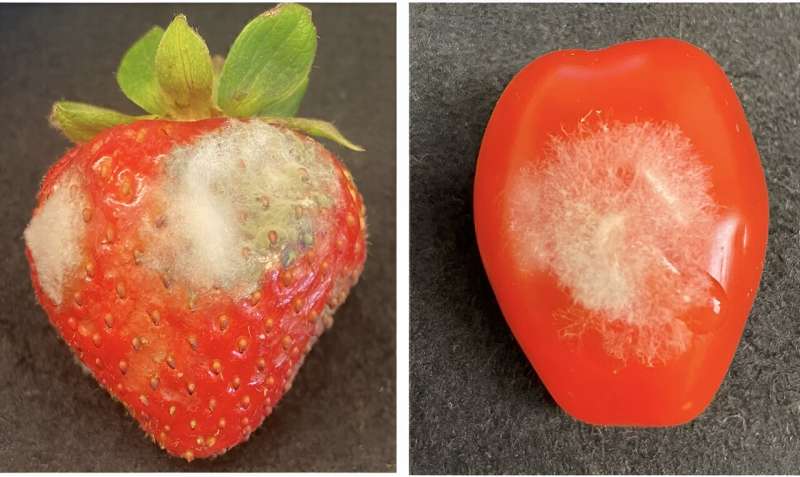This article has been reviewed according to Science X's editorial process and policies. Editors have highlighted the following attributes while ensuring the content's credibility:
fact-checked
peer-reviewed publication
trusted source
proofread
A path to defeating crop-killing gray mold without toxic chemicals

It's a mold that causes billions in crop losses every year, infecting berries, tomatoes and most other fruits and vegetables. Now, researchers have found a way to defeat the mold without showering toxic chemicals on the crops.
If you've ever seen a fuzzy gray strawberry, you've seen gray mold. It affects more than 1,400 different plant species, and there is no real cure for it. Being able to control it may hinge on the discovery of lipid "bubbles" secreted by the mold cells, which some researchers previously dismissed as insignificant.
In fact, new UC Riverside research shows these bubbles are essential for communications between pathogens and their hosts, including many types of fungi, as well as bacteria and mammals. In this case, the researchers found that gray mold has learned how to use the bubbles to achieve successful infections.
"Because they are hard to isolate and study, the important functions of these lipid bubbles, also called extracellular vesicles, have been overlooked for decades," said Hailing Jin, UCR professor of microbiology and plant pathology, who led the research project.
"Now we know the mold, just like its plant hosts, also uses extracellular vesicles to protect and deliver what amount to weapons—small RNA molecules that silence genes involved in plants' immune systems," Jin said.
This finding is detailed in the journal Nature Communications, where the researchers not only show that gray mold secretes virulent RNA in these lipid-based bubbles, but that a particular protein is key to the mold's ability to produce the bubbles.
The protein, tetraspanin, appears on the surface of the bubbles. The researchers found that if they eliminated the mold's ability to make tetraspanin, the mold's ability to secrete and deliver the bubbles was largely reduced.
"If we knock out this key component of the vesicles, we can attenuate their ability to deliver the weapons of small RNAs or other molecules that suppress host immunity," Jin said.
Previously, the same research team also identified genes that allow the fungus to produce small RNA molecules. Knocking out those genes, as well as the ones that allow the fungus to make tetraspanin, would enable a new generation of "RNA fungicides" that inhibit grey mold disease.
"Everything has RNA in it, and it is easily digested by humans and animals. RNA can be degraded quickly in the environment and wouldn't leave any toxic residues," Jin said. Currently the main treatments for gray mold are fungicides and these chemicals can negatively impact human and animal health and our environment."
Gray mold is the second most damaging fungus for food crops in the world, preceded only by the rice pathogen Magnaporthe. An eco-friendly fungicide based on RNA, and which attacks the ability to secrete extracellular vesicles may also be effective against Magnaporthe, and other fungal pathogens.
"With the climate changing so fast, many fungal infections can get worse. We are excited to develop new eco-friendly methods of protecting the global food supply that may be so widely applicable," Jin said.
More information: Baoye He et al, Fungal small RNAs ride in extracellular vesicles to enter plant cells through clathrin-mediated endocytosis, Nature Communications (2023). DOI: 10.1038/s41467-023-40093-4
Journal information: Nature Communications
Provided by University of California - Riverside





















